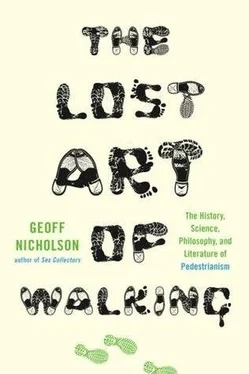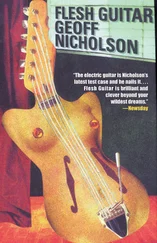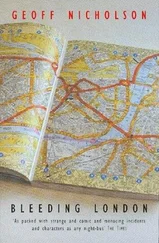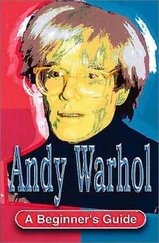♦
I walked for a while in the footsteps of those two great Angelenos Raymond Chandler and his fictional alter ego Philip Marlowe. I had a partial list of the places Chandler had lived, based on information from his selected letters, from two Chandler biographies, plus a certain amount of anecdotal evidence. Chandler seems to have lived everywhere : Los Feliz, Santa Monica, Arcadia, Monrovia, Brentwood, Pacific Palisades, you name it, and all manner of places in between. It made for interesting but ultimately unsatisfying walking. It was easy enough to find the streets, some much meaner than others, but often I couldn’t find the actual addresses. Times and the city had changed too much.
I went, for instance, to Loma Street in what is now MacArthur Park, where Chandler lived in 1916 when he worked as an accountant at the Los Angeles Creamery. The address no longer existed. Later a mailman tried very hard to help me find one of Chandler’s old places on 12th Street, but our best efforts put his apartment exactly where there was now an alleyway that ran behind a Korean Presbyterian church. A bungalow court on Leeward shared an address with somewhere Chandler had once lived, but it was now a series of tightly packed bunkers, neat and recently repainted but thoroughly austere, and enclosed behind spiked iron railings and barbed wire, evoking captivity as much as security. It couldn’t have been like that in Chandler’s time.
My only really good score, easily walked to from my home, was the Spanish-style, ice cream-colored apartment block on Greenwood Place, where Chandler and his wife, Cissy, had lived when he wrote his first short stories for Black Mask magazine. At that time Chandler had lost his job as an oil executive because of alcoholism and its attendant problems, and I’d constructed quite the tragic and romantic picture for Chandler, and for myself. There are some very bleak apartment blocks in that area, and I guessed that Ray and Cissy, with no visible means of support, had holed up in one of these. I was quite wrong. There was nothing bleak about 4616 Greenwood. It looked like a very decent place to live. More than that, it looked like a fully authentic Chandler location: sun-drenched, lush, keeping its secrets. As I paced up and down outside, it was possible to entertain the fantasy that I was tracking down some vital clues about the man and his work. Finding clues, however, was a rarity.
I have since discovered that at the time I was doing these Chandler walks, an author named Judith Freeman was covering a lot of the same territory, researching a book about Chandler’s marriage. She doesn’t seem to have had much more luck than I did at locating genuine Chandler territory, but she wrote the book anyway.
Both of us must, at least occasionally, have walked where Chandler had once walked, and walking with Chandler was probably safer than driving with him, certainly safer than being on the sidewalk when he was behind the wheel. In a letter to Roger Machell, Chandler recalls driving home in his oil executive days, ‘plastered to the hairline in a most agreeable manner…We missed pedestrians by a thin millimeter…laughing heartily at the idea of a man trying to walk on two legs’.
Certainly Chandler’s Marlowe thinks nothing of having a few stiff drinks before and even during a long drive, and we do tend to think of hard-boiled detectives as drivers rather than walkers, but in the course of his inquiries Marlowe, like any good gumshoe, did plenty of walking, too. I thought it might be more rewarding to walk in Marlowe’s mythical city than in the remains of Chandler’s historical one.
I tried, for a start, to find the house where Marlowe lives in The Long Goodbye , ‘in the Laurel Canyon district’, a surprisingly bohemian area for a private eye, even in the 1940 s. The description of Marlowe’s house is what I’ve come to think of as pure Chandler. It sounds very convincingly specific and yet it’s actually deceptively general. ‘It was a small hillside house on a dead end street with a long flight of redwood steps to the front door and a grove of eucalyptus trees across the way’.
There is no Yucca Drive in Laurel Canyon, but there is a Yucca Trail (which is not a dead end), and sure enough when I walked there, I saw at least two houses that fit the bill in terms of steps and eucalyptus trees. Did Chandler scout this street, walk the neighborhood looking for a suitable fictional home for his detective? I do like to think so.
In the novel, Terry Lennox, the ambiguously appealing, white-haired, facially reconstructed semi-villain, walks to Marlowe’s place from Fountain Avenue, a long and perilous ascent, steep as a ski slope in places, made more taxing by blind bends and drivers who have no expectation whatsoever of encountering anyone on foot.
Marlowe himself walks to Laurel Canyon in The Big Sleep , to the house of one Arthur Gwynne Geiger. He walks there from the Sternwood mansion in West Hollywood, first covering ‘ten blocks of curving, rain swept streets’ until he ‘comes out at a service station’, then adds, ‘I made it back to Geiger’s house in something over half an hour of nimble walking’.
I have walked various routes between various possible locations for both the mansion and Geiger’s house, but convincing though Chandler’s (and Marlowe’s) account is, the geography of the book is a long way off from the real geography of the city. There are no ten curving blocks, there is no suitably placed gas station. The best guess has Geiger living on Kirkwood Terrace, a street off Laurel Canyon Boulevard, with the Sternwood mansion a ringer for the Dabney mansion, a mock Tudor extravaganza in Beverly Hills, sometimes used as a movie set ( Murder, She Wrote, The Witches of Eastwick, The Prestige ) and also the site of a real murder.
The Big Sleep is also the novel in which Marlowe follows on foot a customer from Geiger’s bookstore, a sort of porno lending library, situated on the north side of Hollywood Boulevard near Las Palmas Avenue, a place that can be located today with some precision. Some sources place the bookstore in what is now the ‘new room’ of Musso & Frank’s restaurant, one of Chandler’s favorite watering holes, a taste shared by such writer/drinkers as Fitzgerald, Faulkner, Parker, Hammett, and Bukowski.
Marlowe tails the customer, who gets increasingly panicky as he walks west on Hollywood Boulevard to Highland, then another block, then turns right and then left into a ‘narrow tree lined street with three bungalow courts’, the second of which is called La Baba. Eventually the customer cracks, ditches the smut he’s borrowed, and then saunters away, leaving Marlowe to retrieve the filthy goods.
The first part of the walk is easily replicated, but by the end you’ll find yourself walking into Hollywood and Highland, a corporate, multistory shopping mall that by some accounts is responsible for the revitalization of Hollywood, but which nevertheless has the look of something that will be a slum in ten years’ time. Chandler would have been horrified, and would have reveled in his horror.
However, my favorite Marlowe walking moment appears in Farewell, My Lovely , where he climbs the 280 steps up to Cabrillo Street in Montemar Vista, where he’s got an appointment with a popinjay called Lindsay Marriott. ‘It was a nice walk if you like grunting’, Marlowe says.
Cabrillo Street and Montemar Vista are Chandler’s inventions, but if you’re looking for a long trudge up a great many steps, Castellammare, on the Pacific Coast Highway, offers a very adequate substitute. I did the climb, and it’s a struggle to find exactly 280 steps — some now lead into dead ends, some are crumbling wood — but you can do something that’s not too far off the mark. The grunting is much as reported, but it really is a ‘nice’ walk, if you like walking. On the way you pass the house where the actress Thelma Todd was murdered, and the view from the top is just about worth the effort.
Читать дальше












